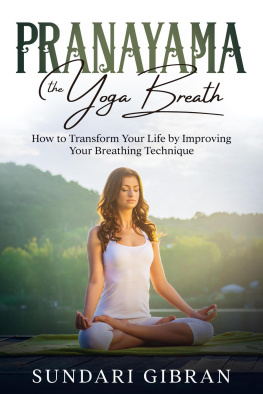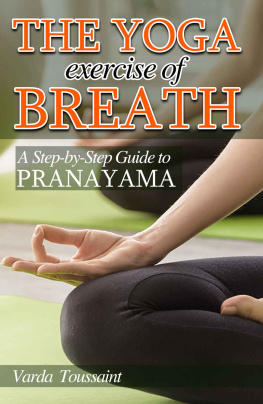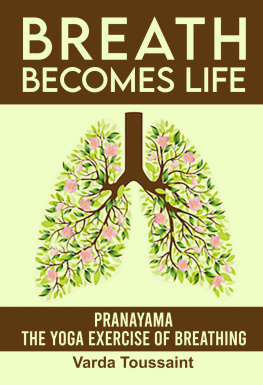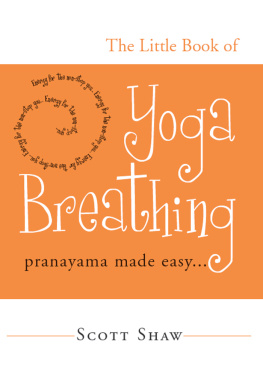Amelita Goldsmith - Pranayama Breathing Exercise Benefits Method Practices
Here you can read online Amelita Goldsmith - Pranayama Breathing Exercise Benefits Method Practices full text of the book (entire story) in english for free. Download pdf and epub, get meaning, cover and reviews about this ebook. year: 2015, genre: Home and family. Description of the work, (preface) as well as reviews are available. Best literature library LitArk.com created for fans of good reading and offers a wide selection of genres:
Romance novel
Science fiction
Adventure
Detective
Science
History
Home and family
Prose
Art
Politics
Computer
Non-fiction
Religion
Business
Children
Humor
Choose a favorite category and find really read worthwhile books. Enjoy immersion in the world of imagination, feel the emotions of the characters or learn something new for yourself, make an fascinating discovery.

- Book:Pranayama Breathing Exercise Benefits Method Practices
- Author:
- Genre:
- Year:2015
- Rating:4 / 5
- Favourites:Add to favourites
- Your mark:
- 80
- 1
- 2
- 3
- 4
- 5
Pranayama Breathing Exercise Benefits Method Practices: summary, description and annotation
We offer to read an annotation, description, summary or preface (depends on what the author of the book "Pranayama Breathing Exercise Benefits Method Practices" wrote himself). If you haven't found the necessary information about the book — write in the comments, we will try to find it.
Pranayama Breathing Exercise Benefits Method Practices — read online for free the complete book (whole text) full work
Below is the text of the book, divided by pages. System saving the place of the last page read, allows you to conveniently read the book "Pranayama Breathing Exercise Benefits Method Practices" online for free, without having to search again every time where you left off. Put a bookmark, and you can go to the page where you finished reading at any time.
Font size:
Interval:
Bookmark:
Pranayama Breathing Exercise
Benefits Method Practices
PRANAYAMA AND BENEFITS
Every human likes to live healthily and happily on earth. However, no one follows the right way. YOGA is the best medicine. Yoga is a Spiritual and Physical discipline that has its roots in India, that might have developed 5 or 6th BCE. Saint Patanjali [Ascetic] is the key person who wrote The Yoga Sutras of Patanjali This Yoga Sutras is key surviving Major text form of Yoga. Yoga described as Soul Therapy practicing Yoga will lead to a stage of higher consciousness.
What is breathing:
First act of Birth Breath
The Last act of life Breath
We inhale atmospheric air, which contains 78 % Nitrogen, oxygen around 21 % and balance 1 % other gases. This air also contains 0.9 % to 0.4% of water vapour depending upon the Sea level. The Human body needs oxygen to sustain. The inhaled air goes to lungs and respiratory system. Alveoli- tiny walled air sacs collect oxygen and send through the bloodstream to the entire body. This blood will supply oxygen wherever required in the body and red cells collect back carbon dioxide to lungs. The rich carbon dioxide and waste gases air exhaled. Again, the process started for next breathing. Dome shaped diaphragm controls the breathing that is in between lungs and stomach. Normal Adult breathing will be 12 to 18 per minute. It can vary in extraordinary situations. Your breathing may go up to 35 -45 when you are angry, exciting movements, extraordinary shocking news / act, physical etc,
Hypoxia is known as decrease in oxygen percentage and Anoxia is very much lack of oxygen. Both Hypoxia and Anoxia conditions can be fatal. Maximum 8 to 10 minutes in anoxia condition will lead to brain damage / death. Human Brain needs 20% of pure enriched oxygen with 680 720 ml of blood per minute. Here the Pranayama plays very a vital role.
Yoga and Pranayama: There are many types of Yoga: Karma Yoga, Japa Yoga, Gnana Yoga, Bhakati Yoga these are all spiritual Yoga. Raja / Astanga Yoga involves eight steps, namely: 1.Yamas 2. Niyamas 3. Asanas 4. Pranayama 5. Pratyhara 6. Dharana 7. Dhyana and 8. Samadi.
What is Pranayama:
Pranayama is Sanskrit word! Prana means Life force, Yama is an extension. Three particular and peculiar way of breathing is process is called Pranayama. First, one is Purak to take a breath inside, the second one is kumbak to retain it and third is rechak discharge it. Pranayama referred as an expansion of individual energy into cosmic energy.
In Kundalini yoga, three Nadis plays a major role. The left side of the brain controlled through Ida Nadi, the right side of the brain controlled by Pingala Nadi and Sushumana Nadi at the center in the spinal cord. Right nostril referred to Pingala Nadi [sun / Body]. The left nostril referred to Ida Nadi [Moon / Mind]. Inhale through the right nostril and exhale through left nostril called lda Nadi. Inhale through left nostril and exhale through right called Pingala Nadi. The alternate breathing will purify both body and mind. It metabolically balances body and mind. The major advantage of alternate breathing balances both Physical energy and mental energy. A fit body is a fit mind.
Now let see how to do Pranayama: you can practice Pranayama early morning between 5 to 6 am with an empty stomach, preferably after a bath. Keep a good ventilated with sufficient lighting peaceful or quiet place / room. The closed room often creates giddiness. Fresh air is necessary for Pranayama. You can choose Neem tree for rich oxidized air. Be seated on a soft cloth or mat on a flat surface. Put your right heel on the left thigh and left heel on the right thigh. Keep your Head and Spine in a straight position. This position is Padmasana or Lotus asana. Pointing your nose, close your eyes and start praying. You can chant Om, Om, and Om and relax yourself. Initially, you mind may not keep quiet, and very difficult to sit. Do not worry. For first one minute, inhale deep breath and exhale slowly. Do it for 10 times. If you are feeling uncomfortable, please relax for 3 minutes. For a week, you can practice until you are comfortable.
Step 2 Sit on Padmasana, as mentioned above. Close right nostril with right thumb slowly inhales through left nostril. Exhale through left nostril slowly. If you are comfortable do it for 10 times. Then close left nostril with the left thumb. Slowly inhale through the right nostril and exhale through right nostril. If you are comfortable do it for 10 times. However, do not forget to relax in-between. Take more time to exhale. If you are taking 5 seconds to inhale, exhale in 8 seconds.
Step 3 Sit on Padmasana as above. Close right nostril with the right thumb. Inhale slowly through left nostril. With little and ring finger close left nostril remove the thumb from right nostril. Exhale through right nostril very slowly. Close left nostril with the left thumb. Inhale slowly through the right nostril. Close right nostril with little and ring finger. Exhale very slowly through left nostril. Practice 10 times for the left and the right side per day. These continue for 10 days.
There are three popular methods of Pranayama:
- Bhastrika Pranayama
- Kapalabhati Pranayama
- Anulom Pranayama
Bhastrika Pranayama: Be seated yourself comfortably either on floor or chair. Sit straight and erected posture. Inhale air forcefully through both nostrils. You can feel the abdomen is coming out. You will feel chest and collarbones are stiffening. Hold for a second and forcibly exhale the air out. Now you can feel the abdomen to normal position, collarbones sagging, Chest, and lungs in deflected position. 10 times, you do continuously, and then relax for one minute.
Kapalbhati Pranayama: Be seated yourself comfortably either on floor or chair. Inhale little air with both nostrils and exhale forcibly through both nostrils. Exhalation should be effortlessly and passively and continue this cycle around 55 to 60 time per minute. If you are tired or feeling giddiness, stop for a while and continue.
Anulom Pranayama: Sit in Padmasana / lotus position, or in a chair, close your eyes pointing nose, close your right nostril with the right thumb. Slowly inhale air through left nostril as much as possible. Hold it. With the help of middle and ring fingers of the right-hand close left nostril. Exhale air completely through the right nostril. Next step, close your left nostril with the right thumb and inhale air through the right nostril. Hold it. Close right nostril with middle and ring fingers. Exhale air through left nostril. This is one cycle of Anulom Pranayama and practices 10 to 15 cycles.
All the mentioned Pranayama are basic methods and should practice under the guidance of proper guru / Teacher / Instructor. Stop practicing if you feel uncomfortable during Padmasana and Pranayama and get proper guidance. Your mind and body brought to a state of happiness. Calm and clean atmosphere can bring peacefulness and stress-free. Repeatedly you feel yourselves you are happy, tensionless, comfortable. You can set your prayers along the Pranayama. While inhaling takes 4 seconds, exhale in 8 seconds. In due course, you can increase the timing 5 seconds for inhale and 10 seconds for exhale. Never force yourselves to attain the extreme stage. Minimum 3 to 6 months, a continuous practice may yield good results. Average of 3 times a day to 5 times a day is healthier practice.
Care and Cautious:
- Select a good place with natural air circulation, Lighting, quite and comfortable to practice.
- Use soft clothing and mat / towel during Pranayama.
- If you want to use a chair, select a comfortable seat.
- Do not teach Pranayama below 12 years children.
- Always practice Asanas first and then Pranayama.
- Minimum 4 hours gap to maintain before doing Pranayama.
Font size:
Interval:
Bookmark:
Similar books «Pranayama Breathing Exercise Benefits Method Practices»
Look at similar books to Pranayama Breathing Exercise Benefits Method Practices. We have selected literature similar in name and meaning in the hope of providing readers with more options to find new, interesting, not yet read works.
Discussion, reviews of the book Pranayama Breathing Exercise Benefits Method Practices and just readers' own opinions. Leave your comments, write what you think about the work, its meaning or the main characters. Specify what exactly you liked and what you didn't like, and why you think so.





